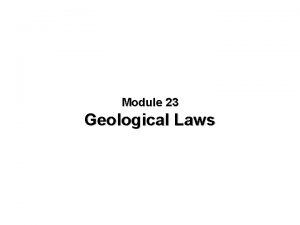Department of Geology and Geological Engineering Van Tuyl

- Slides: 1

Department of Geology and Geological Engineering Van Tuyl Lecture Series- Fall 2014 4: 00 -5: 00 p. m. in Berthoud Hall Room 241 Thursday, October 16, 2014 Dr. Tim Covino Assistant Professor of Watershed Science Department of Ecosystem Science and Sustainability Colorado State University “Physical and Biological Controls on Water and Solute Retention from Reach to Catchment Scales” Abstract: Physical and biological processes occurring within fluvial networks can have strong influence on catchment scale retention of water and nutrients. Quantifying the physical (e. g. , hydrologic exchange) and biological (e. g. , nutrient uptake) contributions to total retention and deciphering how they relate to catchment morphology remains a central challenge in the hydrologic and biogeosciences. In this seminar I synthesize contributions that highlight the interactions between biology, physical hydrology, and catchment morphology and how they combine to influence nutrient retention and streamwater compositions. Further, I highlight how reach scale investigations of coupled physical and biological processes across system gradients provide opportunities to expand system understanding from plot or reach to catchment or stream network extents. I will also emphasize the ability of catchment retention features (e. g. , alluvial aquifers, wetlands, lakes) to play disproportionately large roles in catchment retention relative to their spatial extent and frequency. This research suggests that the geomorphic template, combined with coupled physical and biological processes exert first order controls over catchment retention dynamics and channel network streamwater compositions. These types of data driven analyses and empirical modeling approaches can provide a framework for elucidating internal mechanisms that drive hydrological, biogeochemical, and ecological patterns across entire catchments and fluvial networks.

